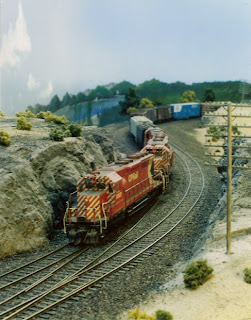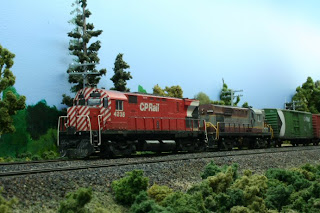 |
A Teoli bathtub gondola in its original paint scheme.
Grahame Morris photo..
|
It was just over 40 years ago that Canadian Anthony Teoli designed North America’s first bathtub gondola car.
According to the patent he filed on June 29, 1970, he wanted to create a “gondola type railway car with a parabolic shape extending down between the wheel assemblies or trucks of the car and free of external or internal reinforcement, giving maximum capacity and minimum car weight.”
Traditional hopper cars, he noted, “usually have a continuous center sill structure extending the length of the car which limits the capacity of the car and produces a relatively high center of gravity in the loaded car, as well as increasing the weight of the car.”
His car was different because it had a “relatively smooth unobstructed interior and is particularly adapted for rotary unloading with a highly effective clean-out of the car.”
What distinguished Teoli’s car from others at the time—and made it instantly recognizable—was its unique curved (parabolic) bottom, which allowed the car to carry more coal. The other distinguishing mark was its sloped ends.
(You can see the actual patent application, including a description of the car and drawings, at http://www.freepatentsonline.com/3713400.pdf.)
One of the first railways to buy Teoli’s design was CP Rail, which used them on its unit coal trains in B.C. As a result, here in Canada these distinctive-looking cars became known as Teoli cars, not as bathtub gondolas.
 |
A page from the CP Rail equipment
data book from June, 1979. |
In the February, 1996 issue of Railroad Model Craftsman, Patrick Lawson noted that Teoli also licensed his design to the Youngstown Company, which then produced the cars in the U.S. (Berwick also used the design to build cars, and the design was later sold to the Thrall Car Company.)
The U.S. version of the car was shortened by 5’6” to fit U.S. rotary dumpers. By 1980, 3,200 cars had been sold, with Union Pacific being one of the major buyers.
Unfortunately, Lawson writes, by shortening the car a weld in a critical stress area began to fail. This prompted U.S. railroads to start buying bathtub gondolas from other companies. The Canadian version, being longer, suffered no such problem, and is still being used to haul coal and sulfur today.
As delivered to CP Rail, the car was painted the railway’s unique Action Red colour. This proved to be a mistake, since the coal quickly made the cars very dirty. Subsequent cars were delivered in black.
 |
| InterMountain Teoli car. |
InterMountain came out with a very prototypical version of this car in the original red, and later black, schemes (see photo above). Athearn also produced a version, but it's too short for CP Rail, and the end ladders are incorrect. Additionally, they got the slant of the CP Rail logo all wrong—it leans way too far to the right (see photo below). On the plus side, it is less expensive than the InterMountain car.
Although the InterMountain cars are perfect for the CP Rail Manitoba & Minnesota Subdivision, I'm almost embarrassed to admit that I don’t actually own any.
Prior to their release, I had begun collecting the (very) unprotypical Roundhouse CP Rail version—it was the only car of its kind available at the time. I have thought about replacing them with the more realistic InterMountain cars, but the price ($35-$45 in Canada) has thus far been an obstacle. Maybe I’ll find them used some day, and make the switch!
Addendum: Thanks to Chris vanderHeide for noting below that the Athearn car matches the American version, while the Intermountain car is the standard Canadian design.
















